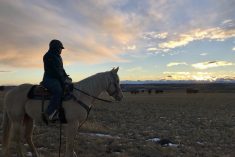If you calve enough cows, sooner or later you’ll see some sort of birth defect — an ugly calf born dead or half-alive with no chance of thriving. For the vast majority, it’s an isolated event and the cause is never uncovered. Some are due to lethal genetic defects, due to a defective gene carried by both parents and one calf can be the best clue to a reproductive issue that’s hard to track down.
The traditional view is that genetic defects are rare, only seen in inbred herds, something most cattlemen don’t need to worry about. But, according to Dr. Bob Weaber, beef genetics extension specialist at the University of Missouri, if you do have a genetic defect problem, it can be a big problem. And, he says, genetic defects have increased in recent years because embryo transfer and increased use of A.I. have enabled a relatively small number of animals to have huge numbers of offspring and descendants.
Read Also

Reintroducing fire to Saskatchewan pastures
Pastures evolve over time. Woody plants and shrubs, which cattle can’t eat, may encroach on natural grasses. Invasive species, such…
The few rare animals with uncommon but very desirable traits or combinations of traits are very heavily used. But, like any animal, these elite stock may bring along “unwanted genetic baggage,” natural mutations that cause no problems when an animal has only one copy of the affected gene but cause fatal defects if an animal has two copies of it.
The Angus bull, GAR Precision 1680, was such an animal. He was one of the first bulls to provide calving ease along with high weaning and yearling weights. He was used in some of the most used bloodlines in the Angus breed and had almost 10,000 direct sons and daughters registered. Recently, GAR Precision 1680 has been identified as a carrier of arthrogryposis multiplex (AM), curly calf syndrome, and neuropathic hydrocephalus (NH). Calves with AM are very small and thin with a twisted spine and other problems. NH calves are very small but have an oversized head with only fluid inside the skull.
Lethal genetic defects are harmless as long as a carrier is not mated to another carrier. A carrier animal is heterozygous for the defect, it has one normal and one defective gene, so it may pass either one to its offspring. In early generations of a carrier’s offspring the defective gene doesn’t cause problems because animals usually have only a single copy. With a bull like GAR Precision 1680, he had so many offspring and they were so widely used, the mutated genes for those lethal defects were passed into many bloodlines. It becomes quite easy to use bulls that appear from their pedigrees to come from unrelated families, but actually have a common ancestor that was a carrier for a genetic defect.
When two heterozygous, carrier animals are mated it’s a toss-up whether they pass the good or the mutated gene to each of their offspring. If both parents contribute normal copies of the gene, as happens in one in four matings, the offspring is normal and homozygous for normal development. If, as happens in half the matings, the offspring receives the normal and the mutated gene, it’s heterozygous, a carrier for the defect. But, in one in four matings the offspring receives mutant copies of the gene from both parents, it develops with characteristic developmental abnormalities.
Lethal genetic defects occur in every breed, not just Angus. Sometimes the same defect occurs in more than one breed — AM occurs in Charolais and Angus, due to different mutations. In breeds where animals could be bred up to achieve registration, there may be a carrier ancestor.
It can be a real challenge to recognize genetic defects. The deformed calf you see may be the tip of an iceberg. Genetic defects can cause resorption of the embryo or abortion. Without seeing these, you blame the cow for reproductive failure. If you have carriers in your herd, you could lose a quarter of the calf crop from a bull and two-thirds of your healthy calves could be carriers.
But, not all congenital abnormalities are caused by gene mutations.
“Don’t assume it’s genetic,” says Weaber. “There’s a lot more congenital defects caused by disease or other, often unknown, things.
Weaber’s advice is to look carefully at any calf that looks deformed at birth.
“Don’t just throw it on the dead pile,” he says. “Take photographs, video it, note the parents if you can and store the calf — put it somewhere cold and safe from scavengers or bag it up and put it in the freezer.
“It’s much more likely to be something else. It could be an infection — BVD early in pregnancy can cause hydrocephalus (fluids making the head swollen) and mouth deformities, cleft palate. Lupin can cause cleft palate and limb deformities.
“Search for images of recognized genetic defects. Have your vet look at the calf and consider sending the calf to a diagnostic lab or running a DNA test on it.”
Weaber also advises checking pedigrees.
“Most often, there’s some degree of inbreeding, even if you can’t find it in conventional pedigrees,” he says. “The solution for a commercial breeder is to switch to crossbreed with a different breed.”
At one time breeders were reluctant to accept that their animals could have caused birth defects. Until recently the only way to identify carriers was through test matings. The alternative was to abandon bloodlines implicated as carriers.
New, rapid, low-cost DNA testing can identify carriers of several genetic defects and they can be removed from the breeding populations or only used in crossbreeding situations. The bigger breed associations have developed regulations to require identification of carriers of genetic defects recognized in their herd books. Seed stock producers can verify their animals are free of several genetic defects through DNA testing.















